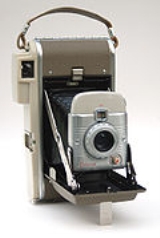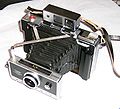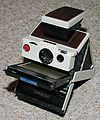
Land Camera
Encyclopedia
Land cameras are instant camera
s with self-developing film
named after their inventor, Edwin Land, manufactured by Polaroid
between the years of 1947 and 1983. Though Polaroid continued producing instant cameras after 1983, the name 'Land' was dropped from the camera name since Edwin Land retired in 1982. The first commercially available model was the Polaroid Land Camera Model 95, which produced prints in about 1 minute,and was first sold to the public in November, 1948.
In 1963, Land introduced Polacolor pack film, which made instant color photographs possible. This process involved pulling two tabs from the camera, the second which pulled the film sandwich through the rollers to develop out of the camera. The instant colour process is much more complex, involving a negative which contains three layers of emulsion sensitive to blue, green, and red. Underneath each layer are dye developing molecules in their complementary colours of yellow, magenta, and cyan. When light strikes an emulsion layer, it blocks the complementary dye below it. For instance, when blue strikes the blue sensitive emulsion layer, it blocks the yellow dye, but allows the magenta and cyan dyes to transfer to the positive, which combine to create blue. When green and red (yellow) strikes their respective layers, it blocks the complementary dyes of magenta and cyan below them, allowing only yellow dye to transfer to the positive.
In 1972, integral film was introduced which did not require the user to time the development or peel apart the negative from the positive. This process was similar to polacolor film with added timing and receiving layers. The film itself integrates all the layers to expose, develop, and fix the photo into a plastic envelope commonly associated with a Polaroid photo. The SX-70 camera was the first to utilize this film.
Improvements in SX-70 film led to the higher speed 600 series film, then to different formats such as 500 series (captiva), and spectra.
.jpg)
, a hardbody rollfilm camera whose film was pulled out of the camera body to develop outside the camera. The film for rollfilm cameras was discontinued in 1992.


autofocus. There were also cheaper non folding versions such as the Pronto! and OneStep.
The last Polaroid cameras made under the Land name were made in the 1980s. They were the Sun 600 models which used a high speed version of SX-70 film, called 600 film, and included a built-in electronic flash.
600 film was used also in later instant Polaroid cameras; however, these were sold only under the Polaroid name. The last 'Land' camera was the Polaroid One 600, which was designed in 2004.
Camera
A camera is a device that records and stores images. These images may be still photographs or moving images such as videos or movies. The term camera comes from the camera obscura , an early mechanism for projecting images...
s with self-developing film
Instant film
Instant film is a type of photographic film first introduced by Polaroid that is designed to be used in an instant camera...
named after their inventor, Edwin Land, manufactured by Polaroid
Polaroid Corporation
Polaroid Corporation is an American-based international consumer electronics and eyewear company, originally founded in 1937 by Edwin H. Land. It is most famous for its instant film cameras, which reached the market in 1948, and continued to be the company's flagship product line until the February...
between the years of 1947 and 1983. Though Polaroid continued producing instant cameras after 1983, the name 'Land' was dropped from the camera name since Edwin Land retired in 1982. The first commercially available model was the Polaroid Land Camera Model 95, which produced prints in about 1 minute,and was first sold to the public in November, 1948.
Film
The process, invented by Polaroid founder Edwin Land, was to employ diffusion transfer to move the dyes from the negative to the positive via a reagent. A negative sheet was exposed inside the camera, then lined up with a positive sheet and squeezed through a set of rollers which spread a reagent between the two layers, creating a developing film sandwich. The negative developed quickly, after which some of the unexposed silver halide grains (and the latent image it contained) were solubilized by the reagent and transferred by diffusion from the negative to the positive. After a minute, the back of the camera was opened and the negative peeled away to reveal the print.In 1963, Land introduced Polacolor pack film, which made instant color photographs possible. This process involved pulling two tabs from the camera, the second which pulled the film sandwich through the rollers to develop out of the camera. The instant colour process is much more complex, involving a negative which contains three layers of emulsion sensitive to blue, green, and red. Underneath each layer are dye developing molecules in their complementary colours of yellow, magenta, and cyan. When light strikes an emulsion layer, it blocks the complementary dye below it. For instance, when blue strikes the blue sensitive emulsion layer, it blocks the yellow dye, but allows the magenta and cyan dyes to transfer to the positive, which combine to create blue. When green and red (yellow) strikes their respective layers, it blocks the complementary dyes of magenta and cyan below them, allowing only yellow dye to transfer to the positive.
In 1972, integral film was introduced which did not require the user to time the development or peel apart the negative from the positive. This process was similar to polacolor film with added timing and receiving layers. The film itself integrates all the layers to expose, develop, and fix the photo into a plastic envelope commonly associated with a Polaroid photo. The SX-70 camera was the first to utilize this film.
Improvements in SX-70 film led to the higher speed 600 series film, then to different formats such as 500 series (captiva), and spectra.
Cameras
.jpg)
Rollfilm
The original cameras folded into the body and utilized bellows to protect the light path. The film was put on two spools, one with the negative roll, and one with the positive paper and reagent pods. The film developed inside the camera. The exception to this is the Polaroid SwingerPolaroid Swinger
The Polaroid Model 20 "Swinger" was a popular Land Camera produced by the Polaroid Corporation between 1965 and 1970. At $19.95 USD it was the first truly inexpensive instant camera, a fact that helped fuel its enormous popularity and made it one of the top-selling cameras of all time...
, a hardbody rollfilm camera whose film was pulled out of the camera body to develop outside the camera. The film for rollfilm cameras was discontinued in 1992.


100 Series Pack cameras
These cameras were developed after the rollfilm models and were designed to use the newly developed 100 series pack film. Like with the Swinger the film sandwich was pulled out of the camera to develop outside of the camera, but instead of two separate rolls the film was built into a compact easy loading film pack which contained 8 exposures. Hard body plastic models were marketed later a low cost alternative to the more expensive models with bellows. There are four generations of folding colorpack cameras the 100, the 200, the 300, and 400 series. Though pack film is still produced and used actively worldwide, Polaroid announced in 2008 the discontinuation of all of its film by 2009. Fujifilm still produces its version of Pack film which is compatible with Land pack film cameras.SX-70 and 600
The SX-70 is a folding SLR camera that takes integral instant film. They were first brought to the market in 1972. There were many models including ones with sonarSonar
Sonar is a technique that uses sound propagation to navigate, communicate with or detect other vessels...
autofocus. There were also cheaper non folding versions such as the Pronto! and OneStep.
The last Polaroid cameras made under the Land name were made in the 1980s. They were the Sun 600 models which used a high speed version of SX-70 film, called 600 film, and included a built-in electronic flash.
600 film was used also in later instant Polaroid cameras; however, these were sold only under the Polaroid name. The last 'Land' camera was the Polaroid One 600, which was designed in 2004.
See also
- Instant filmInstant filmInstant film is a type of photographic film first introduced by Polaroid that is designed to be used in an instant camera...
- Instant cameraInstant cameraThe instant camera is a type of camera that generates a developed film image. The most popular types to use self-developing film were formerly made by Polaroid Corporation....
- Polaroid SX-70Polaroid SX-70The SX-70 is a folding single lens reflex Land Camera which was produced by the Polaroid Corporation from 1972-1981.- History :Though Polaroid had considered a Henry Dreyfus-designed SLR for its Colorpack film, the SX-70 was the first instant SLR and the first camera to use Polaroid's new SX-70...
- Polaroid CorporationPolaroid CorporationPolaroid Corporation is an American-based international consumer electronics and eyewear company, originally founded in 1937 by Edwin H. Land. It is most famous for its instant film cameras, which reached the market in 1948, and continued to be the company's flagship product line until the February...
- Polaroid ImpulsePolaroid ImpulseThe Polaroid Impulse camera model is similar to the Pronto! models using SX-70 film, but instead using Polaroid's 600-series integral film.-External links:* at The Land List: SX-70 Cameras...

